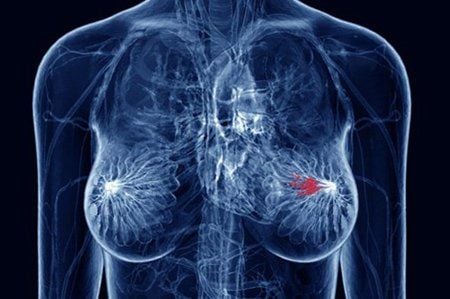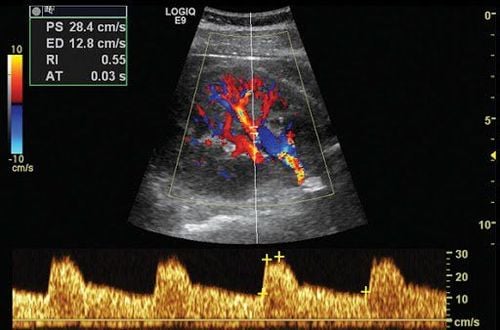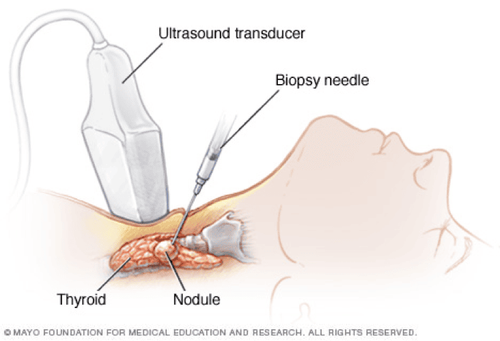This is an automatically translated article.
Article by Master, Doctor Nguyen Thuc Vy - Doctor of Radiology - Department of Diagnostic Imaging - Vinmec Nha Trang International General Hospital.
Elastography of the breast is an ultrasound technique that provides additional properties of breast lesions in addition to conventional ultrasound. Elastography for a noninvasive assessment of lesion stiffness. It increases the specificity of routine B-mode ultrasound in the evaluation of breast lesions.
A recent new study conducted by Elkharbotly et al (2015) shows that combining B mode routine ultrasound with elastography increases the sensitivity, specificity and high diagnostic accuracy. than conventional ultrasound.
1. The basis of ultrasound elastography
Elasticity of a material is expressed as the deformation when it is impacted by an external force and it will return to its original shape and size when this force is no longer available. Depending on the molecular blocks that make up the tissue (fat, fiber...), different tissues will have different elasticity. The stiffer the tissue, the less elastic it will be, and the time it will take to return to its original state after no external force is applied will be slower. Fibrous tissue will have higher stiffness than fat and muscle tissue. Tissue of cancerous lesions tends to be stiffer than normal tissue and this is the basis for the application of ultrasound elastography to differentiate breast lesions.

2. Breast elastography ultrasound methods
With the same principle as ultrasound elastography in other organs, there are two popular methods of elastography in the breast today:
Semiquantitative elastography: using the principle of ultrasound compression elastography. This method is performed by applying pressure from the tip due to ultrasound on the tissue to be examined. When there is pressure acting from the outside, it changes the original shape and diameter front and back. For a soft (highly benign) lesion, when there is pressure, the lesion will change shape and the anteroposterior diameter will be smaller than the original lesion (elastic tissue). In contrast, with hard lesions (high malignancy), because the tissue is hard, when pressed, the shape does not change or changes little, but mainly moves the position up and down and the size of the tumor. nor changed from the original. This method is more widely used because of the first appearance. The disadvantage is that it depends a lot on the sonographer's experience when applying pressure on the transducer to create compression, deep-lying lesions are difficult to perform.
Quantitative method: ultrasonic recording based on shear wave elastography with techniques such as: FIBROSCAN (Echosen), ARFI (Siemens), SWE (Supersonic). This technique does not need to apply compression to the tissue examined, the deformation in the tissue is caused by a pressure pulse of sound waves emitted continuously from the ultrasound transducer. The deformation of the tissue is assessed by measuring the wave velocity in the tissue in cm/s or the stiffness of the tissue in kPascals.
This method has the advantage of being less dependent on the sonographer (since the transducer itself generates negative pressure pulses), providing quantitative information.

3. Value of breast elastography
Breast elastography is intended to provide additional information for conventional B mode and color ultrasound, but cannot do elastography without the information of previous B mode and color ultrasound. The addition of elastography can help upgrade or downgrade BI-RADS for lesions that have been ranked above B mode ultrasound before. The addition of ultrasound elastography features to the 5th edition of BI-RADS Lexicon (BI-RADS Lexicon version 5th, 2013) provided an important tool for increasing the specificity and diagnostic accuracy of BI-RADS Lexicon. Ultrasound of breast lesions. The lesions were first evaluated on B mode with information such as shape, axis, border, vascular status, echogenicity and classified BIRADS by B mode ultrasound. It will then be classified as soft, intermediate or hard according to the criteria of ultrasonic elastography. The final classification of the lesion according to the corrected BI-RADS based on the findings of the elastography will be described in the following table:
4. Clinical application
Increased diagnostic reliability: Positive or negative elastography results affect B-mode ultrasound results and BI-RADS classification of breast lesions. This increases the diagnostic confidence level in distinguishing between benign and malignant lesions, leading to early and accurate diagnosis Reduces unnecessary short-term follow-up: a lesion is classified as BI-RADS class 3 On B-mode ultrasound, short-term follow-up (06 months) up to two years is advised. If these lesions are tender on elastography, they can be classified as BI-RADS type 2 (benign lesions), reducing unnecessary follow-up. Transition from short-term follow-up to biopsy: Some well-defined malignant breast lesions may be misinterpreted on B-mode ultrasound and thus be misclassified as BI-RADS type 3 lesions, leading to a delay guess. Elastography helped differentiate these lesions by elasticity and upgraded BI-RADS to class 4, leading to an indication for a biopsy for the lesion. Changing the decision on biopsy to short-term follow-up: Lesions with low suspicion of malignancy BI-RADS type 4a can be converted to BI-RADS type 3 depending on the elasticity of the lesion on elastography. Conclusion:
Breast elastography is a useful imaging modality that enhances the specificity and sensitivity of the diagnosis of various breast lesions when combined with B-mode ultrasound findings.
Vinmec International General Hospital is currently using GE Healthcare's LOGIQ S8 ultrasound machine (USA) with integrated color ultrasound and tissue elastography with B mode ultrasound to help support accurate diagnosis of lesions. breast according to international guidelines (BI-RADS Lexicon version 5th).
Please dial HOTLINE for more information or register for an appointment HERE. Download MyVinmec app to make appointments faster and to manage your bookings easily.
References
Imtiaz S. Breast elastography: A new paradigm in diagnostic breast imaging. App Radiol. 2018;47(3):14-19 (https://appliedradiology.com/articles/breast-elastography-a-new-paradigm-in-diagnostic-breast-imaging).














